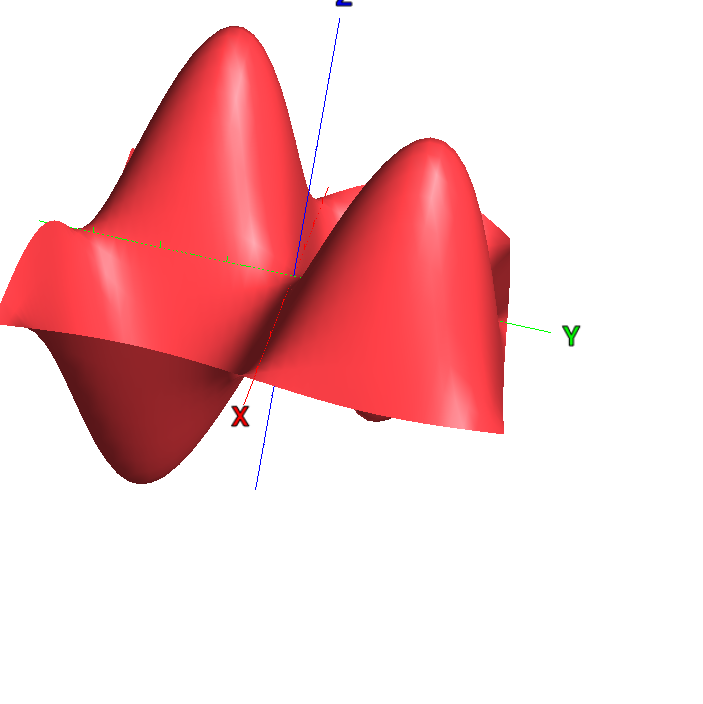Physicist: Frequently in quantum mechanics you’ll find that particles are restricted to only a certain set of states or locations, and yet somehow they can move from one to the next. It’s like moving between islands without crossing any water.
“Classically” (19th century, pre-relativity, pre-quantum) this is impossible. If you see a particle in one place and then see it again, but in a new place, then of course it must have traversed the distance from one to the other.
But here’s the essential difference between quantum mechanics (correct) and classical physics (wrong): particles aren’t solid objects that have a genuine position, instead they’re waves that are “smeared out”.
A standing wave (like a guitar string, or an electron orbital) usually has “nodes” where the wave is always zero.

The string remains stationary in the middle, but the wave has no problem getting past that point. This image stolen, unrepentantly, from http://people.rit.edu/andpph/text-string-vibrations.html.
But of course there’s a big difference between the wave being zero at a node, and the wave being unable to get to the other side of that node. It’s the difference between the string in the above picture, and what you would have if you nailed that string to a piece of wood at the node and left the bottom half dangling.
For you calculus buffs out there, the difference is hidden away in the derivatives.
If you have a particle (wave) like this and you measure where it is many times you’ll find that it’s on the top about half the time, on the bottom about half the time, and never ever in the middle (ever).

The shape of the standing waves formed inside a microwave oven. The peaks and troughs move up and down, but the lines in between are stationary and zero. This is why microwaves have rotating plates, to keep food from sitting in the nodes (and staying cold) or from staying in the peak areas (and burning).
One of my personal fave examples of “large scale” quantum weirdness is microwave ovens. A microwave oven creates a standing wave of photons with a “plus-shaped” (+) node, which leaves the center of the chamber especially cold. The chance of finding a photon anywhere on the plus-shaped-node is zero. So there are four different cells that it should be impossible for the microwave photons to move between, but they don’t seem to mind at all. It’s not like particles exist or something.
So thinking of things like electrons as particles leads to incorrect conclusions. Thinking of them as waves is really the way to go.







but according to de broglis eq the electron is a paricle ,it means that was classic mechanics but he also considered them as waves
well im not satisified
Are you arguing that electrons are always waves or always particles?
He is referring to the “De Broglie hypothesis”
e=h*Lambda
De Broglie theorized that electrons behave both as a wave, as you describe, and as a particle. I advise looking it up, as I’m not confident on the explanation.
thanks for the cool site people ! sorry to bother you with my ignorance. my question is do electron waves have nodes? why is the particle never in the middle? it is just infinate or what? happy to donate a few bucks to you guys.
Willful ignorance is no good, but learning what you don’t know (I think) is a virtue.
That said; yes, they do have nodes. Unfortunately, when you think about particles to try to figure out how tiny things behave you run into one problem after another. This is just one example.
Different waves have different nodes. For example the first harmonic has no modes (so the question doesn’t really come up), the second harmonic has one mode (like in the post above), the third harmonic has two modes, etc.
So, why the particle is never in a particular place is that the wave has a node there, and that just has to do with how waves bounce around and interfere with themselves (standing waves).
The reason that we “see” a “particle” in a particular place when we interact with a wave function is tricky, but ultimately falls out of the math.
While the idea of particles is kinda comforting, the best way to understand what’s going on is to think of the wave taking up the entire area, as opposed to a single particle bouncing around doing impossible things.
why cant we make a marker or two in the electron wave?
What kind of marker, and what for?
Okay so does this also explain how a particle can be in two places at once? Because it is actually a wave that is spread out so to speak and has no definite location? Just making sure.
Pretty much!
Is there any measurments of how far a electron “jumps”? In that case what is the distance of the longest meassured jump and is the lenght of the jump relative to the speed of the electron?
Judging from the above comments; our existance is perhaps a hologram, or perhaps there is another type of hologram yet to be discovered.
Perhaps this is the reason behind the fact that there is a black hole at the centre of every galaxy. We are made up of a projection coming from that black hole.
Is someone or something playing a game then? Who is in charge of the projector?
Does this mean our brains, which run on electrons and electrical/chemical signals, also travel through other dimensions? Can anyone explain cogently the quantum enigma?
i want to ask questions, can we move one place to another place without actually crossing the middle distance.
i mean can matter go from one position to another distance position without go through the middle space.
may there is a middle way by which we can direct cross the space.. with any narrow hole or something
I have a question, As we know that we reside in 3D, so to how many dimensions does the subatomic world belong
Stationary waves are formed within an orbit and not between the orbits then how the wave passes between the orbits
The question “how can electrons jump between places without covering the intervening distance” contains improper assumptions that create paradoxes. You will always see these paradoxes until you see the phenomena as physicists see it. The electron is not a particle as we know it. In Quantum Field Theory, it is best seen mathematically as a mathematical operator operating on a mathematical space. “jump between places” is another assumption. If you try analyzing the “continuity concept”, using human experience, you’ll also have a paradox. It has a mathematical definition that is quite complex, depending on whether you look at it from a topology perspective, or as from a metric perspective. The concept determines how you see the mathematical spaces and its functions. The mathematical spaces in both the quantum and macro world, are not the same spaces we see in our human world. “Jump” connotes travel. Yet, what we see as a particle travel in our space, is seen by physicists according to the math describing the phenomena. For example, relativistic mechanics see motion as a symmetry-preserving hyperbolic rotation in Riemann space that preserves an important invariant. in conclusion, if you want to resolve these paradoxes, you have to see it as a physicist sees it.
So now , as a student , what should I consider an electron , is it dual natured ?
if thought waves travel on electrons can those thoughts be in two places at the same time, we are talking instantaneous repositioning of thoughts. just and idea!
We are all the subtleties of the same wave. One single wave smeared out everywhere. The wave becomes changed (shaped) upon the interactions that occur within itself. How else could you describe one commonality between all things? How could you develop a mathematical theory of everything unless there is one commonality among all which is observed and not observed by us?
Pingback: Quantum Physics May Upend Our Macroscopic Reality In The Universe - Science and Tech News